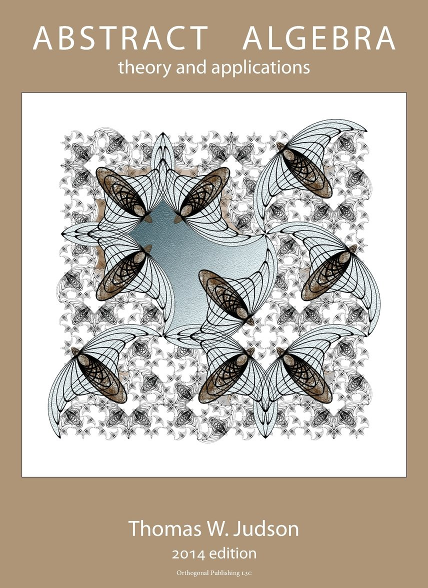Exercises 3.5 Exercises
1.
Find all
(a) \(3 + 7 \mathbb Z = \{ \ldots, -4, 3, 10, \ldots \}\text{;}\) (c) \(18 + 26 \mathbb Z\text{;}\) (e) \(5 + 6 \mathbb Z\text{.}\)
2.
Which of the following multiplication tables defined on the set
(a) Not a group; (c) a group.
3.
Write out Cayley tables for groups formed by the symmetries of a rectangle and for
4.
Describe the symmetries of a rhombus and prove that the set of symmetries forms a group. Give Cayley tables for both the symmetries of a rectangle and the symmetries of a rhombus. Are the symmetries of a rectangle and those of a rhombus the same?
5.
Describe the symmetries of a square and prove that the set of symmetries is a group. Give a Cayley table for the symmetries. How many ways can the vertices of a square be permuted? Is each permutation necessarily a symmetry of the square? The symmetry group of the square is denoted by
6.
Give a multiplication table for the group
7.
Let
8.
Give an example of two elements
Pick two matrices. Almost any pair will work.
9.
Prove that the product of two matrices in
10.
Prove that the set of matrices of the form
is a group under matrix multiplication. This group, known as the Heisenberg group, is important in quantum physics. Matrix multiplication in the Heisenberg group is defined by
11.
Prove that
12.
Let
Prove that
13.
Show that
14.
Given the groups
15.
Prove or disprove that every group containing six elements is abelian.
There is a nonabelian group containing six elements.
16.
Give a specific example of some group
Look at the symmetry group of an equilateral triangle or a square.
17.
Give an example of three different groups with eight elements. Why are the groups different?
The are five different groups of order 8.
18.
Show that there are
Let
be in \(S_n\text{.}\) All of the \(a_i\)s must be distinct. There are \(n\) ways to choose \(a_1\text{,}\) \(n-1\) ways to choose \(a_2\text{,}\) \(\ldots\text{,}\) 2 ways to choose \(a_{n - 1}\text{,}\) and only one way to choose \(a_n\text{.}\) Therefore, we can form \(\sigma\) in \(n(n - 1) \cdots 2 \cdot 1 = n!\) ways.
19.
Show that
for all
20.
Prove that there is a multiplicative identity for the integers modulo
21.
For each
22.
Show that addition and multiplication mod $n$ are well defined operations. That is, show that the operations do not depend on the choice of the representative from the equivalence classes mod
23.
Show that addition and multiplication mod
24.
Show that multiplication distributes over addition modulo
25.
Let
26.
Let
27.
Prove that the inverse of
28.
Prove the remainder of Proposition 3.2.14: if
29.
Prove Theorem 3.2.16.
30.
Prove the right and left cancellation laws for a group
31.
Show that if
Since \(abab = (ab)^2 = e = a^2 b^2 = aabb\text{,}\) we know that \(ba = ab\text{.}\)
32.
Show that if
33.
Let
34.
Find all the subgroups of
35.
Find all the subgroups of the symmetry group of an equilateral triangle.
\(H_1 = \{ id \}\text{,}\) \(H_2 = \{ id, \rho_1, \rho_2 \}\text{,}\) \(H_3 = \{ id, \mu_1 \}\text{,}\) \(H_4 = \{ id, \mu_2 \}\text{,}\) \(H_5 = \{ id, \mu_3 \}\text{,}\) \(S_3\text{.}\)
36.
Compute the subgroups of the symmetry group of a square.
37.
Let
38.
Let
39.
Let
40.
where
41.
Prove that
is a subgroup of
The identity of \(G\) is \(1 = 1 + 0 \sqrt{2}\text{.}\) Since \((a + b \sqrt{2}\, )(c + d \sqrt{2}\, ) = (ac + 2bd) + (ad + bc)\sqrt{2}\text{,}\) \(G\) is closed under multiplication. Finally, \((a + b \sqrt{2}\, )^{-1} = a/(a^2 - 2b^2) - b\sqrt{2}/(a^2 - 2 b^2)\text{.}\)
42.
Let
Prove that
43.
Prove or disprove:
44.
List the subgroups of the quaternion group,
45.
Prove that the intersection of two subgroups of a group
46.
Prove or disprove: If
Look at \(S_3\text{.}\)
47.
Prove or disprove: If
48.
Let
is a subgroup of
49.
Let
Since \(a^4b = ba\text{,}\) it must be the case that \(b = a^6 b = a^2 b a\text{,}\) and we can conclude that \(ab = a^3 b a = ba\text{.}\)
50.
Give an example of an infinite group in which every nontrivial subgroup is infinite.
51.
If
52.
Prove or disprove: Every proper subgroup of an nonabelian group is nonabelian.
53.
Let
Prove
54.
Let
Exercise Group.
In each group, how many solutions are there to
59.
This is an odd-numbered exercise with tasks.
(a)
What is
\(2\)
(b)
This task has subtasks.
(i)
What is
\(6\)
(ii)
What is
\(10\)
60.
This is an even-numbered exercise with tasks.
(a)
What is
\(4\)
(b)
This task has subtasks.
(i)
What is
\(8\)
(ii)
What is
\(12\)


